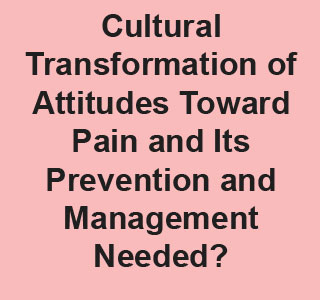
The panel asked for cooperative and national endeavors by public and private organizations to bring about a cultural transformation in the ways a nation comprehends and organizes pain management and prevention. The recommendations can be put to effect by the end of 2012 while others can be managed by 2015 with continual efforts.
“Given the large number of people who experience pain and the enormous cost in terms of both dollars and the suffering experienced by individuals and their families, it is clear that pain is a major public health problem in America. All too often, prevention and treatment of pain are delayed, inaccessible, or inadequate. Patients, health care providers, and our society need to overcome misperceptions and biases about pain. We have effective tools and services to tackle the many factors that influence pain and we need to apply them expeditiously through an integrated approach tailored to each patient ,” explained committee chair Philip Pizzo, dean, Carl and Elizabeth Naumann Professor of Pediatrics, and professor of microbiology and immunology, Stanford University School of Medicine, Stanford, Calif.
The estimated cost mentioned above seems to be a restricted one as it does not include pains in children or army men. Professionals may have to keep in mind that although pain is universal, it depends on individual experiences and necessitates a combined effect of therapies and coping strategies. Scientists believe that pain is something more than a mere physical symptom and sometimes even eliminating the root cause doesn’t seem to resolve the problem. Continued pain can lead to major alterations in the nervous system and become a lethal disease by itself. Furthermore, pain varies between people because of different factors like genes, cultural beliefs towards adversities, stress, depression, knowledge of health information, and other behavioral issues.
An efficient treatment will need organization and a unified approach that is responsive to all factors that result in pain. Primary care providers are deemed to enable most of the care and management including specialty care centers for more chronic cases. Health care institutions are expected to develop self managing attributes in patients by varied methods and coaching. Training programs ought to include pain education in their curricula and support interdisciplinary learning. Many institutions don’t seem to incorporate pain care guidelines as per a study which revealed that only 5 of the country’s 133 medical schools had included pain care courses. Regular assessment of pain related queries and knowledge are also essential including advanced pain care.
The report is inclusive of Medicare, Medicaid, workers’ compensation programs, and private health means to find methods for interdisciplinary pain care. Individual care may require sufficient time to counsel patients and guardians, multiple consultations, and more than one type of medication which is not the case presently. Pain is touted to take a heavy toll on individuals if left unattended. The report recommends NIH to further such studies and widen the scope and resources of the current Pain Consortium. The study encourages collaboration of NIH with private firms to being about new medications and therapies.
The study was mandated by Congress and sponsored by the National Institutes of Health.
